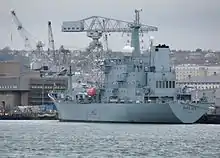HMNB Devonport
Her Majesty's Naval Base, Devonport (HMNB Devonport) is one of three operating bases in the United Kingdom for the Royal Navy (the others being HMNB Clyde and HMNB Portsmouth) and is the sole nuclear repair and refuelling facility for the Royal Navy. The largest naval base in Western Europe,[1] HMNB Devonport is located in Devonport, in the west of the city of Plymouth, England.
| HMNB Devonport | |
|---|---|
| Plymouth, Devon in England | |
 An aerial photograph of the core of HMNB Devonport in 2005 with several ships alongside. | |
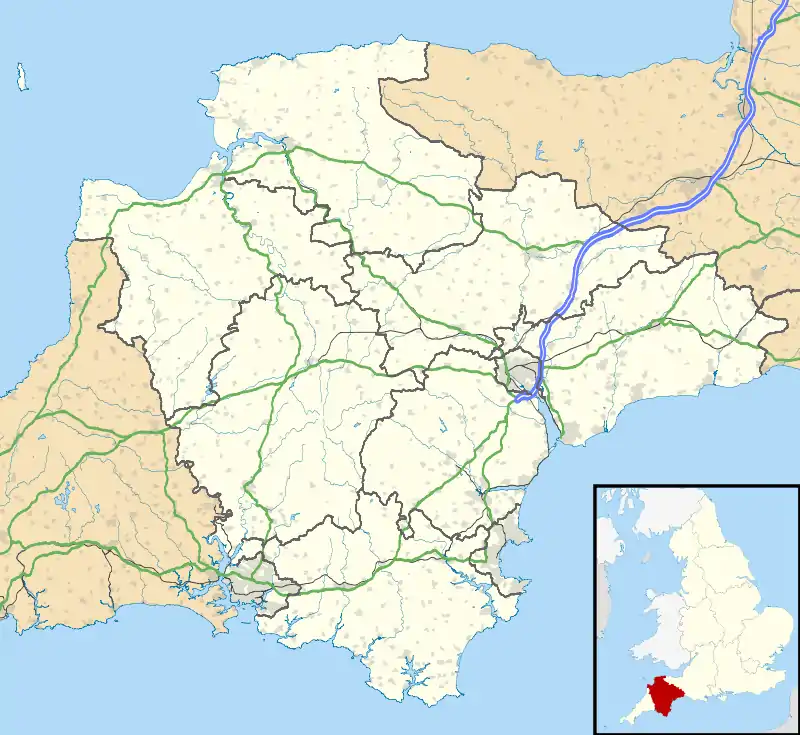 HMNB Devonport Location in Devon | |
| Coordinates | 50°22′58.8″N 04°10′58.8″W |
| Type | Naval base |
| Area | 263 hectares (650 acres) |
| Site information | |
| Owner | Ministry of Defence (Defence Equipment and Support) |
| Operator | Royal Navy |
| Controlled by | Naval Base Commander, Devonport |
| Condition | Operational |
| Website | Official website |
| Site history | |
| Built | 1691 |
| In use | 1691 – present |
| Events | Plymouth Blitz (1941) |
| Garrison information | |
| Garrison | Devonport Flotilla |
The base began as Royal Navy Dockyard in the late 17th century, but shipbuilding ceased at Devonport in the early 1970s, although ship maintenance work has continued. The now privatised maintenance facilities are operated by Babcock Marine, a division of Babcock International Group, who took over the previous owner Devonport Management Limited (DML) in 2007. DML had been running the Dockyard since privatisation in 1987.[2]
From 1934 until the early 21st century the naval barracks on the site was named HMS Drake (it had previously been known as HMS Vivid after the base ship of the same name). The name HMS Drake and its command structure has been extended to cover the entire base. The barracks buildings are now named the Fleet Accommodation Centre.[3] In the early 1970s the newly styled 'Fleet Maintenance Base' was itself commissioned as HMS Defiance; it remained so until 1994, when it was amalgamated into HMS Drake.
HM Naval Base Devonport is the home port of the Devonport Flotilla which includes the Trafalgar-class submarines. In 2009 the Ministry of Defence announced the conclusion of a long-running review of the long-term role of three naval bases. Devonport would no longer be used as a base for attack submarines after these moved to Faslane by 2017, and the Type 45 destroyers are based at Portsmouth. However, Devonport retains a long-term role as the dedicated home of the amphibious fleet, survey vessels and half the frigate fleet.[4]
History

In 1588, the ships of the English Navy set sail for the Spanish Armada through the mouth of the River Plym, thereby establishing the military presence in Plymouth. Sir Francis Drake is now an enduring legacy in Devonport, as the naval base has been named HMS Drake.[1]
Origins

In 1689 Prince William of Orange became William III and almost immediately he required the building of a new Royal Dockyard west of Portsmouth. Edmund Dummer, Surveyor of the Navy, travelled the West Country searching for an area where a dockyard could be built; he sent in two estimates for sites, one in Plymouth, Cattewater and one further along the coast, on the Hamoaze, a section of the River Tamar, in the parish of Stoke Damerel. Having dismissed the Plymouth site as inadequate, he settled on the Hamoaze area which soon became known as Plymouth Dock, later renamed Devonport. On 30 December 1690, a contract was let for a dockyard to be built: the start of Plymouth (later Devonport) Royal Dockyard.[5] Having selected the location, Dummer was given responsibility for designing and building the new yard.
At the heart of his new dockyard, Dummer placed a stone-lined basin, giving access to what proved to be the first successful stepped stone dry dock in Europe.[6] Previously the Navy Board had relied upon timber as the major building material for dry docks, which resulted in high maintenance costs and was also a fire risk. The docks Dummer designed were stronger with more secure foundations and stepped sides that made it easier for men to work beneath the hull of a docked vessel. These innovations also allowed rapid erection of staging and greater workforce mobility. He discarded the earlier three-sectioned hinged gate, which was labour-intensive in operation, and replaced it with the simpler and more mobile two-sectioned gate. A further, double-dock (i.e. long enough to accommodate two ships of the line, end to end) was added, just north of the basin, in the 1720s.[7]
Dummer wished to ensure that naval dockyards were efficient working units that maximised available space, as evidenced by the simplicity of his design layout at Plymouth Dock. He introduced a centralised storage area (the quadrangular Great Storehouse) alongside the basin, and a logical positioning of other buildings around the yard. The southern boundary of his yard was formed by a 'double' rope-house (combining the previously separate tasks of spinning and laying within a single building); the upper floor was used for the repair of sails and a separate rigging house stood nearby. The smithery with its fire and forge was positioned to the north, safely separate from the other buildings. On high ground overlooking the rest of the yard he built a grand terrace of thirteen three-storey houses for the senior dockyard officers (the first known example in the country of a palace-front terrace); the commissioner was accommodated in the centre, and at each end of the terrace was a two-storey block of offices (one for the commissioner, the other for the Clerk of the Cheque).[8] A chapel was built in 1700, alongside the Porter's Lodge at the main gate[9] (it was destroyed by a fire in 1799).[10]
Most of these buildings and structures were rebuilt over ensuing years, including Dummer's original basin and dry dock (today known as No. 1 Basin and No. 1 Dock).[11] The terrace survived into the 20th century, but was largely destroyed in the Blitz along with several others of Devonport's historic buildings. Just one end section of the terrace survives; dating from 1692 to 1696, it is the earliest surviving building in any royal dockyard.[8]
Development

From its original 17th-century site, the dockyard expanded in stages (first to the south and then progressively northwards) over the next 2 1⁄2 centuries.
The town that grew around the dockyard was called Plymouth Dock up to 1823, when the townspeople petitioned for it to be renamed Devonport. The dockyard followed suit twenty years later, becoming Devonport Royal Dockyard. In just under three centuries, over 300 vessels were built at Devonport, the last being HMS Scylla in 1971.[12]
South Yard
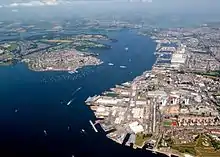
The dockyard began in what is now known as the South Yard area of Devonport. It was here that Dummer built his groundbreaking stone dry dock (completely rebuilt in the 1840s). The numbers employed at the yard increased from 736 in 1711 to 2,464 in 1730.
In the 1760s a period of expansion began, leading to a configuration which (despite subsequent rebuildings) can still be seen today : five slipways, four dry docks and a wet basin (slipways were used for shipbuilding, but the main business of the eighteenth-century yard was the repair, maintenance and equipping of the fleet, for which the dry docks and basin were used).[13] One slipway (1774) survives unaltered from this period (Slip No.1): a rare survival.[14] It is covered with a timber superstructure of 1814, a similarly rare and early survival of its type; indeed, only three such timber slip covers have survived in Britain, two of them at Devonport (the second of these, of similar vintage, stands over the former No.5 Slip; it was later converted to house the Scrieve Board, for full-size drafting of ship designs).[15] The two additional docks were added, north of the double-dock, in 1762 and 1789 (both subsequently rebuilt).[9]
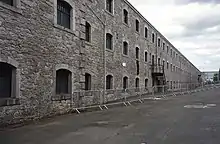
Before the expansion could begin, a rocky hillside to the south had to be cut away; the rubble was used to reclaim the mudflats ready for building.[16] To open up the site, the old ropehouse was demolished and a new rope-making complex built alongside the east perimeter wall of the expanded site (where it still survives in part, albeit rebuilt following a fire in 1812). Where the old ropehouse had stood a short canal known as the Camber was laid out, terminating in a boat basin with a boathouse.[9] On the New Ground to the south a new smithery was constructed, in 1776, containing 48 forges; though subsequently rebuilt it too still stands, the earliest surviving smithery in any royal dockyard.[17] Initially used for the manufacture of anchors and smaller metal items, it would later be expanded to fashion the iron braces with which wooden hulls and decks began to be strengthened; as such, it provided a hint of the huge change in manufacturing technology that would sweep the dockyards in the nineteenth century as sail began to make way for steam, and wood for iron and steel.[13]
The most imposing building of this period was a double-quadrangular storehouse of 1761 (probably designed by Thomas Slade); replacing the Dummer's storehouse, it also incorporated a new rigging house and sail loft. It remained in use until it was destroyed in the Plymouth Blitz; the same fate befell several other buildings of the 18th and early 19th century, including the long and prominent pedimented workshop with its central clocktower, built to accommodate a range of woodworkers and craftsmen, the adjacent pedimented dockyard offices and Edward Holl's replacement Dockyard Church of 1814.[16]

The dockyard suffered severe damage in a large-scale fire on 25 September 1840, it started in the North Dock on HMS Talavera and Imogene were completely gutted, threatened the HMS Minden, and spread to nearby buildings and equipment. Estimates for the damage were put at £150,000 in the values of the day, and would have totalled £500,000 had the fire not been contained by demolishing several surrounding buildings.[18]
Despite significant damage during the blitz, the South Yard still contains four scheduled monuments and over thirty listed buildings and structures[19] (though some of these have been allowed to fall into a derelict state in recent years: the 18th-century South Sawmills and South Smithery are both on the Heritage at Risk Register).[20][21] In the space between the new slips and the new ropehouse, south of the boat pond, was a sizeable mast pond, flanked by mast-houses.[9]
Morice Yard (New Gun Wharf)
Provision of ships' armaments was not the responsibility of the Navy but of the independent Board of Ordnance, which already had a wharf and storage facility in the Mount Wise area of Plymouth. This, however, began to prove insufficient and in 1719 the board established a new gun wharf on land leased from one Sir Nicholas Morice, immediately to the north of the established Dockyard. The Morice Yard was a self-contained establishment with its own complex of workshops, workers, officers, offices and storehouses. Gunpowder was stored on site, which began to be a cause for concern among local residents (as was the older store in the Royal Citadel within the city of Plymouth). In time new gunpowder magazines were built further north, first at Keyham (1770s), but later (having to make way for further dockyard expansion) relocating to Bull Point (1850).[28]
In contrast to South Yard, which fared badly in the Blitz, most of the original buildings survive at Morice Yard, enclosed behind their contemporary boundary wall; over a dozen of these are listed.[19] On higher ground behind the wharf itself is a contemporary terrace of houses for officers (1720), built from stone rubble excavated during the yard's construction.[13]
Morice Ordnance Yard remained independent from the dockyard until 1941, at which point it was integrated into the larger complex.
The Devonport Lines
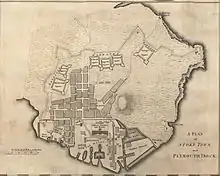
In 1758, the Plymouth and Portsmouth Fortifications Act provided the means to construct a permanent landward defence for the dockyard complex. The Devonport Lines were a bastion fortification which consisted of an earthen rampart with a wide ditch and a glacis. The lines ran from Morice Yard on the River Tamar, enclosing the whole dockyard and town, finally meeting the river again at Stonehouse Pool, a total distance of 2,000 yards (1,800 metres). There were four bastions, Marlborough Bastion to the north, Granby Bastion to the north-east, Stoke Bastion to the east and George Bastion to the south east. There were originally two gates in the lines, the Stoke Barrier at the end of Fore Street and the Stonehouse Barrier. A third gate called New Passage was created in the 1780s, giving access to the Torpoint Ferry. After 1860, the fortifications were superseded by the Palmerston Forts around Plymouth and the land occupied by the lines was either sold or utilised by the dockyard.[29]
Keyham (the North Yard)
.JPG.webp)
In the mid-nineteenth century, all royal dockyards faced the challenge of responding to the advent first of steam power and then metal hulls. Those unable to expand were closed; the rest underwent a transformation through growth and mechanisation.
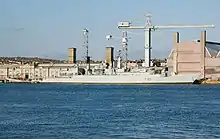
At Devonport, in 1864, a separate, purpose-built steam yard was opened on a self-contained site at Keyham, just to the north of Morice Yard (and a tunnel was built linking the new yard with the old). A pair of basins (8–9 acres each) were constructed: No. 2 Basin gave access to three large dry-docks, while No. 3 Basin was the frontispiece to a huge integrated manufacturing complex. This became known as the Quadrangle: it housed foundries, forges, pattern shops, boilermakers and all manner of specialized workshops. Two stationary steam engines drove line shafts and heavy machinery, and the multiple flues were drawn by a pair of prominent chimneys. The building still stands, and is Grade I listed; architectural detailing was by Sir Charles Barry. English Heritage calls it 'one of the most remarkable engineering buildings in the country'.[13] The three dry docks were rebuilt, expanded and covered over in the 1970s to serve as the Frigate Refit Centre.[2]
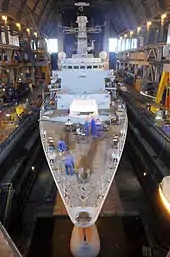
In 1880 a Royal Naval Engineering College was established at Keyham, housed in a new building just outside the dockyard wall alongside the Quadrangle where students (who joined at 15 years of age) gained hands-on experience of the latest naval engineering techniques. The Engineering College moved to nearby Manadon in 1958; the Jacobethan-style building then went on to house the Dockyard Technical College for a time, but was demolished in 1985.[16]

In 1895 the decision was taken to expand the Keyham Steam Yard to accommodate the increasing size of modern warships. By 1907 Keyham, now renamed the North Yard, had more than doubled in size with the addition of No. 4 and No. 5 Basins (of 10 and 35 acres respectively), linked by a very large lock-cum-dock, 730 ft in length, alongside three more dry-docks of a similar size, able to "accommodate ships larger than any war-vessel yet constructed".[30] In the 1970s the northern end of No. 5 Basin was converted to serve as a new Fleet Maintenance Base, to be built alongside a Submarine Refit Complex for nuclear submarines; an 80-ton cantilever crane, one of the largest in western Europe, was installed to lift nuclear cores from submarines in newly built adjacent dry docks.[2]
Further north still, Weston Mill Lake (at one time Devonport's coaling yard) was converted in the 1980s to provide frigate berths for the Type 22 fleet.[31] It is now where the Navy's amphibious warfare ships are based. In 2013 a new Royal Marines base, RM Tamar, was opened alongside; as well as serving as headquarters for 1 Assault Group Royal Marines, it can accommodate marines, alongside their ships, prior to deployment.[32]
In 2011 the MOD sold the freehold of the North Yard to the Dockyard operator, Babcock; the site includes six listed buildings and structures, among them the Grade I listed Quadrangle.[33]
The naval barracks (HMS Drake)
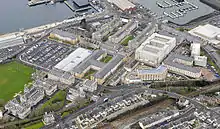
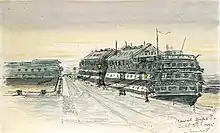
Until the late nineteenth century, sailors whose ships were being repaired or refitted, or who were awaiting allocation to a vessel, were accommodated in floating hulks. Construction of an onshore barracks, just north-east of the North Yard, was completed in 1889 with accommodation for 2,500; sailors and officers moved in in June of that year. In 1894 a contingent of sixty Royal Navy homing pigeons was accommodated on the site.
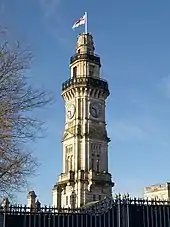
The prominent clock tower was built in 1896, containing a clock and bell by Gillett & Johnston; it initially functioned as a semaphore tower. 1898 saw the barracks expand to accommodate a further 1,000 men. The wardroom block dates from this period. More buildings were added in the early years of the twentieth century, including St Nicholas's Church.[34] This part of the site contains some fourteen listed buildings and structures.[19]
Today
The Royal Navy Dockyard consists of fourteen dry docks (docks numbered 1 to 15, but there is no 13 Dock),[1] four miles (6 km) of waterfront, twenty-five tidal berths, five basins and an area of 650 acres (2.6 km2). The dockyard employs 2,500 service personnel and civilians, supports circa 400 local firms and contributes approximately 10% to the income of Plymouth.[35] It is the base for the Trafalgar-class nuclear-powered hunter-killer submarines and the main refitting base for all Royal Navy nuclear submarines. Work was completed by Carillion in 2002 to build a refitting dock to support the Vanguard-class Trident missile nuclear ballistic missile submarines. Devonport serves as headquarters for the Flag Officer Sea Training, which is responsible for the training of all the ships of the Navy and Royal Fleet Auxiliary, along with many from foreign naval services. The nuclear submarine refit base was put into special measures in 2013 by the Office for Nuclear Regulation (ONR) and it could be 2020 before enhanced monitoring ceases. Safety concerns on ageing facilities, stretched resources and increasing demand are blamed for the measures.[35]
Devonport Flotilla
Ships based at the port are known as the Devonport Flotilla. This includes the Navy's assault ships HMS Albion and HMS Bulwark. It also serves as home port to most of the hydrographic surveying fleet of the Royal Navy and seven Type 23 frigates. In 2018 the Defence Secretary announced that the proposed new Type 26 frigates would all be based at Devonport.[36]
Amphibious assault ships

- HMS Albion landing platform dock;
- HMS Bulwark landing platform dock (Regeneration refit 2020).
Type 23 frigates
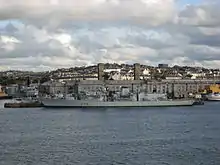
- HMS Argyll
- HMS Monmouth (In extended readiness)
- HMS Montrose (Currently forward deployed to Bahrain for 3 years from 2019)
- HMS Northumberland
- HMS Richmond
- HMS Portland (Completing LIFEX refit)
- HMS Somerset (Completing LIFEX refit)
- HMS Sutherland (Currently in LIFEX refit)
- HMS St Albans (Currently in LIFEX refit)
In changes to base porting arrangements announced in November 2017, HM Ships Argyll, Monmouth and Montrose will join the Portsmouth Flotilla; HM Ships Westminster, Richmond, Kent and St Albans will move in the opposite direction. Richmond becomes a Devonport ship on completion of her refit. St Albans moved to Devonport in July 2019 in preparation for her major refit.[37]
Antarctic patrol ship
Other units based at Devonport
- Flag Officer Sea Training
- Hydrographic, Meteorological & Oceanographic Training Group
- HQ Amphibious Task Group
- HMS Vivid RNR
- RM Tamar/47 Commando Royal Marines
- 10 Landing Craft Training Squadron
- 4 Assault Squadron
- 6 Assault Squadron
- 9 Assault Squadron
- 539 Assault Squadron
- Hasler NSRC (Naval Service Recovery Centre) & Hasler Company Royal Marines
- Southern Diving Group RN
- Defence Estates South West
- HQ Western Division Ministry of Defence Police
- CID Devonport MOD Police
- DSG Devonport MOD Police
South Yard redevelopment
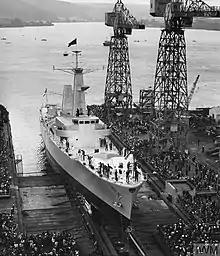
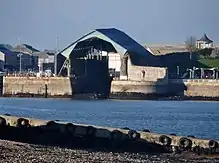
Several sections of the historic South Yard are no longer used by the Ministry of Defence, though it is still currently a closed site and subject to security restrictions.
The deep-water access it offers has made the site desirable for manufacturers of 'superyachts' and in 2012 Princess Yachts acquired the freehold to 20 acres at the southern end, with a view to building a construction facility.[38] The company asserts that this development will "continue the boat building tradition within the dockyard" and "add drama to the site with yachts being moved around the quayside, launched on No. 3 Slip, tested in No. 2 Slip and moored alongside the quay wall".[39] The site includes within it several listed buildings and scheduled ancient monuments, most notably the Grade I listed East Ropery,[40] together with several other 18th-century buildings and structures associated with rope-making in the Yard, the covered slip (No. 1 Slip) and the 'King's Hill Gazebo', built to commemorate a visit by King George III.[41]
In 2014 it was announced, as part of a 'City Deal' regeneration agreement, that the South Yard would be 'unlocked' with a view to it becoming a 'marine industries hub'.[42] As of 2016 the northern section of the South Yard (including the 18th-century dry docks, Nos. 2, 3 & 4)[43][44][45] was being redeveloped in phases,[46] with a marketing strategy focused on 'the development of marine industries and the high growth area of marine science and technology';[47] it has been renamed Oceansgate.
Areas to the south and east (with the exception of the area now occupied by Princess Yachts) are being retained by the MOD,[48] with No. 4 Slip having been recently refurbished for use with landing craft.[2]
Museum
.jpg.webp)
The Devonport Naval Heritage Centre is a maritime museum in Devonport's Historic South Yard.[50] Run by volunteers, it is only accessible for pre-booked tours, or on Naval Base open days. Plymouth Naval Base Museum opened in 1969 following an appeal from the office of the Admiral-superintendent for items of memorabilia and was housed in the Dockyard Fire Station. Since then, the museum has expanded and now occupies, in addition, the 18th-century Pay Office[51] and Porter's Lodge. The Scrieve Board (Project Managed by PDM) currently serves as a museum store.[2] Discussions were underway in 2014 around removing the museum from the Dockyard and displaying some of its collections within an expanded Plymouth City Museum and Art Gallery.[52]
The nuclear-powered submarine HMS Courageous, used in the Falklands War, is preserved in North Yard as a museum ship, managed by the Heritage Centre.
Nuclear submarine decommissioning
Thirteen out of service nuclear submarines were stored at Devonport in 2018.[53]
- HMS Conqueror
- HMS Warspite
- HMS Courageous (defuelled and preserved in North Yard as a museum ship)
- HMS Valiant
- HMS Splendid
- HMS Sovereign
- HMS Spartan
- HMS Superb
- HMS Trafalgar
- HMS Sceptre
- HMS Turbulent
- HMS Tireless
- HMS Torbay
In 2018, the UK Parliament's Public Accounts Committee criticised the slow rate of decommissioning of these submarines, with the Ministry of Defence admitting that it had put off decommissioning due to the cost.[54] The National Audit Office in 2019 stated that the costs of laid up storage of all nuclear submarines had reached £500 million,[55] and they represent a liability of £7.5 billion.[56]
Nickname
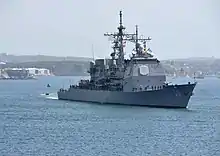
The Naval base at Devonport is still nicknamed "Guzz" (or, sometimes, "Guz") by sailors and marines. One suggestion is that this originates from the word guzzle (to eat or drink greedily), which is likely to refer to the eating of cream teas, a West Country delicacy and, therefore, one with strong connections to the area around Plymouth.[57] Another explanation advanced is that "GUZZ" was the radio call sign for the nearby Admiralty wireless station (which was GZX) at Devil's Point,[58] though this is disputed and has recently been disproved by reference to actual wireless telegraphy callsigns in existence over the past century.[59]
Another explanation is that the name came from the Hindi word for a yard (36 inches), "guz", (also spelled "guzz", at the time) which entered the Oxford English Dictionary,[60] and Royal Navy usage,[61] in the late 19th century, as sailors used to regularly abbreviate "The Dockyard" to simply "The Yard", leading to the slang use of the Hindi word for the unit of measurement of the same name.[62] The Plymouth Herald newspaper attempted[63] to summarise the differing theories, but no firm conclusion was reached. Charles Causley referred to Guz in one of his poems, "Song of the Dying Gunner A.A.1", published in 1951.[64]
A "tiddy oggy" is naval slang for a Cornish Pasty and which was once the nickname for a sailor born and bred in Devonport.[65] The traditional shout of "Oggy Oggy Oggy" was used to cheer on the Devonport team in the Navy's field gun competition.
Nuclear waste leaks
Devonport has been the site of a number of leaks of nuclear waste associated with the nuclear submarines based there.
- November 2002: "Ten litres of radioactive coolant leaked from HMS Vanguard"[66]
- October 2005: "Previous reported radioactive spills at the dockyard include one in October 2005, when it was confirmed 10 litres of water leaked out as the main reactor circuit of HMS Victorious was being cleaned to reduce radiation."[67]
- November 2008: "The Royal Navy has confirmed up to 280 litres of water, likely to have been contaminated with tritium, poured from a burst hose as it was being pumped from the submarine in the early hours of Friday."[67]
- March 2009: "On 25 March radioactive water escaped from HMS Turbulent while the reactor's discharge system was being flushed at the Devonport naval dockyard"[68]
Administration
Commissioners of the Navy
Up until 1832 the Plymouth Royal Dockyard, was administered by a Commissioner of the Navy on behalf of the Navy Board in London included:[69][70][71]
Resident Commissioners Plymouth
- Captain Henry Greenhill, appointed 25 December 1691
- Captain George St Lo, appointed 26 March 1695
- Captain William Wright, appointed 1 May 1703
- Captain Henry Greenhill, appointed February 1704
- Captain William Wright, appointed 1 July 1708
- Captain Richard Edwards, appointed 19 June 1711
- Captain Sir William Jumper Kt., appointed 12 November 1714
- Captain Thomas Swanton, appointed 30 March 1715
- Captain Francis Dove, appointed 23 July 1716
- Captain Sir Nicholas Trevanion, appointed 22 April 1726
- Captain Matthew Morris, appointed 9 December 1737
- Captain Philip Vanbrugh, appointed 8 January 1738
- Captain Sir Frederick Rogers, Bart., appointed 3 October 1753
- Captain Paul Henry Ourry, appointed 30 January 1775
- Mr Edward Le Cras, appointed December 1782
- Captain Sir John Laforey, Bart., appointed 6 May 1784
- Captain Robert Fanshawe, appointed 13 November 1789
- Captain William Shield, appointed 12 December 1815 – 1822
Resident Commissioners Devonport
- Captain William Shield, 1823–1828
- Captain Charles B H Ross, appointed 13 March 1829.
By An Order in Council dated 27 June 1832 the role of the commissioner was replaced by an admiral-superintendent.[72]
Admiral Superintendents of the yard
In 1832 the Navy Board was abolished, everything except the gun wharves were brought under the direct control of the Admiralty. A serving Royal Navy officer, usually of rear-admiral rank, was appointed as admiral-superintendent of the dockyard; however, the post was sometimes held by a commodore-superintendent or even a vice-admiral. They were responsible for all the civilian support services operated by the dockyard departments.
- Rear-Admiral Sir John Louis, Bart., appointed 16 December 1846
- Commodore Lord John Hay CB appointed 9 February 1850;
- Commodore Michael Seymour, appointed 8 September 1851
- Rear-Admiral Hon. Montagu Stopford, appointed 21 March 1854
- Rear-Admiral Henry Eden, appointed 4 August 1854
- Rear-Admiral Michael Seymour, appointed 12 December 1854
- Rear-Admiral Sir James Hanway Plumridge KCB, appointed 19 February 1855
- Rear-Admiral Sir Thomas Sabine Pasley Bart, appointed 4 December 1857
- Rear-Admiral Thomas Matthew Charles Symonds CB, appointed 1 December 1862
- Vice-Admiral Hon. James Robert Drummond CB, appointed 24 April 1866
- Rear-Admiral William Houston Stewart GCB, appointed 5 June 1870
- Vice-Admiral Sir William King-Hall KCB, appointed 20 November 1871
- Rear-Admiral William Charles Chamberlain, appointed 5 August 1875
- Rear-Admiral George Ommanney Willes GCB, appointed 1 May 1876
- Rear-Admiral Charles Webley Hope, appointed 1 February 1879
- Rear-Admiral Charles Thomas Curme, appointed 20 February 1880
- Rear-Admiral John Crawford Wilson, appointed 23 February 1885
- Vice-Admiral Henry Duncan Grant CB, appointed 10 July 1885
- Vice-Admiral Sir Walter James Hunt-Grubbe KCB, appointed 1 August 1888
- Rear-Admiral Sir Robert Henry More Molyneux KCB, appointed 4 August 1891
- Rear-Admiral Edmund John Church, appointed 7 August 1894
- Rear-Admiral Henry John Carr, appointed 3 November 1896
- Vice-Admiral Sir Thomas Sturges Jackson, appointed 7 July 1899
- Rear-Admiral William Hanam Henderson, appointed 11 July 1902 (made Vice-Admiral while in post, 1904)
- Vice-Admiral Charles James Barlow DSO, appointed 31 March 1906
- Vice-Admiral Charles Henry Cross, appointed 31 March 1908
- Vice-Admiral Robert Henry Simpson Stokes, appointed 4 October 1910
- Rear-Admiral Godfrey Harry Brydges Mundy MVO, appointed 11 December 1913
- Rear-Admiral Sir Arthur Henniker-Hughan Bart, appointed 18 December 1916
- Rear-Admiral Edwin Veale Underhill CB, appointed 1 September 1919
- Rear-Admiral Hugh Lindsay Patrick Heard CB DSO, appointed 20 September 1922
- Vice-Admiral Louis Charles Stirling Woollcombe CB MVO, appointed 1 November 1926
- Vice-Admiral Oliver Backhouse CB (retired), 1 March 1927 and re-appointed 10 October 1929
- Vice-Admiral Harold Owen Reinold CB CVO, appointed 2 March 1931
- Vice-Admiral Arthur Lionel Snagge CB, appointed 1935
- Vice-Admiral Arthur Ninian Dowding CB, appointed 27 September 1938
- Vice-Admiral Randolph Stewart Gresham Nicholson CB DSO DSC, appointed 18 December 1945
- Admiral Philip King Enright CB CBE, appointed 6 February 1950
- Vice-Admiral Leslie Newton Brownfield CB CBE, appointed 31 March 1954
- Vice-Admiral Lancelot Arthur Babington Peile CB DSO MVO, appointed November 1957
- Vice-Admiral George David Archibald Gregory, CB DSO, appointed 29 September 1960
- Rear-Admiral A J Cawthra CB, appointed 2 April 1964
- Rear-Admiral Denis Bryan Harvey "Dick" Wildish, appointed 26 October 1966 until May 1970
On 30 December 1970, Vice-Admiral J R McKaig CBE was appointed as Port Admiral, Her Majesty's Naval Base, Devonport, and Flag Officer, Plymouth. On 5 September 1971, all Flag Officers of the Royal Navy holding positions of Admiral Superintendents at Royal Dockyards were restyled as Port Admirals.[74]
Port Admiral Devonport and Flag Officer Plymouth
Post holders included:[75]
- Vice-Admiral Sir Rae McKaig, appointed December 1970 – March 1973
- Vice-Admiral Sir Arthur Power, appointed March 1973 – February 1975
- Vice-Admiral Sir Gordon Tait, appointed February 1975 – January 1977
- Vice-Admiral Sir John Forbes, appointed January 1977 – January 1979
- Vice-Admiral Sir Peter Berger, appointed January 1979 – February 1981
- Vice-Admiral Sir Simon Cassels, appointed February 1981 – September 1982
- Vice-Admiral Sir David Brown, appointed September 1982 – 1985
- Vice-Admiral Sir Robert Gerken, appointed September 1985 – March 1987
- Vice-Admiral Sir John Webster, appointed March 1987 – April 1990
- Vice-Admiral Sir Alan Grose, appointed April 1990 – September 1992
- Vice-Admiral Sir Roy Newman, appointed September 1992 – 1996
Associated establishments nearby
Several establishments were set up in the vicinity of Devonport and Plymouth in direct relationship either to the Royal Dockyard or to Plymouth's use as a base for the Fleet, including:
- Royal Citadel, Plymouth (1665), built to defend the harbour and anchorage, currently the base of 29 Commando Regiment, Royal Artillery.
- Dockyard defences, including Devonport Lines (1758) and the later Palmerston Forts, Plymouth
- Royal Naval Hospital, Stonehouse (1760, closed 1995)
- Stonehouse Barracks (1779), headquarters of 3 Commando Brigade, Royal Marines.
- Admiralty House, Mount Wise (1789), former headquarters of the Commander-in-Chief, Plymouth (together with the Second World War Combined Military Headquarters (later Plymouth Maritime Headquarters) it was decommissioned in 2004).[76]
- Plymouth Breakwater (1812)
- Royal William Victualling Yard (1835) built by the Victualling Commissioners in nearby Stonehouse for supplying the Royal Navy (closed 1992 and converted into housing).
- HMS Raleigh, RN basic training establishment, across the Hamoaze at Torpoint, Cornwall.
- RM Turnchapel, a former Royal Marines military installation (decommissioned 2014).
References
- "HMNB Devonport". Archived from the original on 8 January 2007.
- "Devonport in the Twentieth Century". Historic England.
- Devonport Naval Base Handbook, 2010 Archived 5 April 2015 at the Wayback Machine
- Hansard House of Commons (23 February 2015) Defence questions
- Wessom, William (24 September 2007). "The Devonport Royal dockyard". Archived from the original on 22 October 2012. Retrieved 4 October 2009.
- Fox, Celina (2007). "The Ingenious Mr Dummer: Rationalizing the Royal Navy in Late Seventeenth-Century England" (PDF). Electronic British Library Journal. p. 26. Retrieved 6 October 2009.
- Historic England Grade II* listing: No 2 Dock, including bollards and capstans
- Historic England. "Listed building text (1378525)". National Heritage List for England. Retrieved 13 August 2015.
- The Picture of Plymouth. London: Rees & Curtis. 1812. pp. 102–115.
- "Plymouth Dockyard 1698 – 1843". Science Museum Group. Retrieved 2 August 2019.
- Historic England. "Listed building description (1388409)". National Heritage List for England. Retrieved 31 August 2016.
- "BBC – Plymouth's proud naval history". Retrieved 19 March 2016.
- Heritage, English. "Thematic Survey of English Naval Dockyards". Archived from the original on 4 February 2013.
- Historic England. "Listed building description (1388431)". National Heritage List for England. Retrieved 31 August 2016.
- Historic England. "Listed building description (1388417)". National Heritage List for England. Retrieved 31 August 2016.
- Coad, Jonathan (2013). Support for the Fleet: architecture and engineering of the Royal Navy's bases 1700–1914. Swindon: English Heritage.
- Historic England. "Listed building description (1392692)". National Heritage List for England. Retrieved 31 August 2016.
- "Dreadful Fire at Devonport". London: The Morning Chronicle. 25 September 1840. Archived from the original on 17 March 2019. Retrieved 26 April 2020.
- "Historic England". Retrieved 30 August 2016.
- "HAR register – Sawmills". Historic England.
- "HAR register – Smithery". Historic England.
- England, Historic. "NUMBER 4 STORE (MO 70), City of Plymouth – 1378551- Historic England". historicengland.org.uk.
- England, Historic. "NUMBER 6 SAIL LOFT (MO 61), City of Plymouth – 1378562- Historic England". historicengland.org.uk.
- England, Historic. "NUMBER 5 STORE, COLOUR LOFT (MO 56), City of Plymouth – 1378560- Historic England". historicengland.org.uk.
- England, Historic. "THE OFFICERS TERRACE (MO 63) AND ATTACHED RAILINGS, REAR WALLS AND OUTBUILDINGS, City of Plymouth – 1378564- Historic England". historicengland.org.uk.
- England, Historic. "NUMBER 3 STORE (MO 66), City of Plymouth – 1378559- Historic England". historicengland.org.uk.
- England, Historic. "NUMBER 2 STORE AND FORMER FURBISHERS SHOP (MO 68), City of Plymouth – 1378550- Historic England". historicengland.org.uk.
- English Heritage: Thematic History of Ordnance Yards and Magazine Depots Archived 22 August 2014 at the Wayback Machine
- "Plotting Plymouth's Past – Devonport's Dock Lines" (PDF). www.plymouth.gov.uk. Old Plymouth Society. Archived from the original (PDF) on 28 April 2016. Retrieved 20 April 2016.
- Liz Cook. "1914 Guide for Visitors to Devonport Dockyard". Retrieved 19 March 2016.
- MacIntyre, H. (1992). "Weston Mill Lake, HM Naval Base Devonport: Construction of a jetty using concrete caissons". Proceedings of the Institution of Civil Engineers - Water Maritime and Energy. Institution of Civil Engineers. 96 (4): 227–234. doi:10.1680/iwtme.1992.21672. Retrieved 15 July 2017.
- "RM Tamar". MOD. Retrieved 1 September 2016.
- "MOD Heritage Report 2009–2011". UK Government.
- A history of HMS Drake
- Morris, Jonathan. "Devonport nuclear base has special measures extended". BBC News. Retrieved 14 July 2015.
- "All Type 26 Frigates To Be Based At Devonport". Forces Network. Retrieved 5 February 2019.
- "Defence Secretary announces Type 23 base port moves". www.royalnavy.mod.uk.
- "Boss of Plymouth's Princess Yachts vows not to cut any of 2,200 staff". Plymouth Herald. Archived from the original on 24 September 2015. Retrieved 19 March 2016.
- "Historic Impact Assessment" (PDF). Plymouth City Council. Princess Yachts. Retrieved 31 August 2016.
- Historic England. "Listed building description (1388400)". National Heritage List for England. Retrieved 31 August 2016.
- Historic England. "Listed building description (1388430)". National Heritage List for England. Retrieved 31 August 2016.
- "Historic City Deal could unlock business boom and 10,000 jobs for Plymouth". Plymouth Herald. Archived from the original on 24 September 2015. Retrieved 19 March 2016.
- Historic England. "Listed building description No2 (1432153)". National Heritage List for England. Retrieved 31 August 2016.
- Historic England. "Listed building description No3 (1432208)". National Heritage List for England. Retrieved 31 August 2016.
- Historic England. "Listed building description No4 (1432211)". National Heritage List for England. Retrieved 31 August 2016.
- "Marketing brochure" (PDF). Plymouth City Council. Archived from the original (PDF) on 13 September 2016. Retrieved 31 August 2016.
- "Marine Industries Demand Study Report" (PDF). Plymouth City Council. Archived from the original (PDF) on 13 September 2016. Retrieved 31 August 2016.
- "The Site". Oceansgate Plymouth. Retrieved 31 August 2016.
- Historic England. "Listed building description (1378506)". National Heritage List for England. Retrieved 31 August 2016.
- "Website Disabled". Plymouthnavalmuseum.com. Retrieved 6 November 2012.
- Historic England. "Listed building description (1388408)". National Heritage List for England. Retrieved 31 August 2016.
- "Naval heritage centre set for city centre move as part of £21m history development". The Herald. Archived from the original on 13 May 2014. Retrieved 31 August 2016.
- "The painfully slow process of dismantling ex-Royal Navy nuclear submarines | Save the Royal Navy". www.savetheroyalnavy.org. Retrieved 18 May 2019.
- "Multiple risks to delivery of nuclear deterrent – News from Parliament". UK Parliament. Retrieved 18 May 2019.
- "NAO hits out at UK MoD over nuclear submarine disposal | Jane's 360". www.janes.com. Retrieved 18 May 2019.
- Higginson, Nick (30 July 2019). "Strategy for submarines". Nuclear Engineering International. Retrieved 6 December 2019.
- "Pompey, Chats and Guz: the Origins of Naval Town Nicknames | Online Information Bank | Research Collections | Royal Naval Museum at Portsmouth Historic Dockyard". Royalnavalmuseum.org. Archived from the original on 20 December 2010. Retrieved 6 November 2012.
- Moseley, Brian (February 2011). "Plymouth, Royal Navy Establishments – Royal Naval Barracks (HMS Vivid / HMS Drake)". The Encyclopaedia of Plymouth History. Plymouth Data. Archived from the original on 18 March 2012. Retrieved 13 February 2015. (citing Brimacombe, Peter, "The History of HMS Drake", Rodney Brimacombe, Mor Marketing, Plymouth, July 1992.)
- See, for example: Dykes, Godfrey. "THE_PLYMOUTH_COMMAND". Retrieved 20 August 2011.
- "A Minor case: OED contributions from a prison cell".
- Bedford, Sir Frederick (1875). Royal Navy "Sailor's Pocket Book".
- "The Plymouth Command – Origin of the Nickname GUZZ".
- "Why are Plymouth and Devonport called Guzz". Plymouth Herald. Archived from the original on 24 September 2015. Retrieved 19 March 2016.
- Neil Philip, Michael McCurdy. "War and the pity of war". p. 57. Retrieved 6 November 2012.
- Jolly, Rick (1989), Jackspeak: A guide to British Naval slang & usage, Conway (Bloomsbury Publishing Plc) ISBN 978-1-8448-6144-6 (p. 462)
- "Radioactive leak at Devonport". BBC News. 28 November 2002. Retrieved 4 May 2010.
- Enforcer, The (11 November 2008). "Radioactive leak at Devonport". This is Plymouth. Archived from the original on 29 May 2009. Retrieved 6 November 2012.
- Edwards, Rob (18 May 2009). "Ministry of Defence admits to further radioactive leaks from submarines". The Guardian. London. Retrieved 4 May 2010.
- Archives, The National. "Navy Board and Admiralty: Yard Pay Books". discovery.nationalarchives.gov.uk. The National Archives, 1660 to 1857, ADM 42. Retrieved 19 December 2017.
- Beatson, Robert (1788). A Political Index to the Histories of Great Britain and Ireland: Or, A Complete Register of the Hereditary Honours, Public Offices, and Persons in Office, from the Earliest Periods to the Present Time. Oxford, England: G. G. J. & J. Robinson. pp. 352–353.
Sir Edward Gregory 1703.
- Moseley, Brian. "Old Devonport: Commissioners of Dockyard". olddevonport.uk. Old Devonport 5 May 2017. Retrieved 19 December 2017.
- Writer.), E. MILES (Nautical; Miles, Lawford (1841). An epitome, historical and statistical, descriptive of the Royal Naval Service of England. By E. M., with the assistance of ... L. Miles ... With ... illustrations, etc. Ackermann & Company. p. 88.
- Mackie, Colin. "Royal Navy Appointments from 1865" (PDF). gulabin.com. Colin Mackie, p105, December 2017. Retrieved 19 December 2017.
- "1971 – Admiral Superintendents become Port Admirals – Portsmouth Royal Dockyard Historical Trust". portsmouthdockyard.org.uk. Portsmouth Historical Dockyard Trust. Retrieved 19 December 2017.
- Mackie, Colin. "Royal Navy Senior Appointments from 1865: (Flag Officer, Plymouth from 1969 until 1996" (PDF). gulabin.com. Colin Mackies. p.71. 2018. Retrieved 22 March 2018.
- "Historical information on Subterranea Britannica".
Bibliography
- Duffy, Michael (2019). "William James's Record of the Work Done at Devonport Yard During the War by the Engineering Department". In MacDougall, Philip (ed.). British Dockyards in the First World War. Transactions of the Naval Dockyards Society. 12: Conference held at the National Maritime Museum, Greenwich, March 2014. Southwick, UK: The Naval Dockyards Society. pp. 123–139. ISBN 978-1-9164797-1-5.
External links
- HMNB Devonport web page
- Babcock International Group plc., the owner of the dockyard
- Devonport Naval Heritage Centre
- Oceansgate – marketing site for the South Yard development
- http://interactive.britishart.yale.edu/british-marine-painting/2051/a-geometrical-plan-and-west-elevation-of-his-majesty’s-dock-yard-near-plymouth-with-the-ordnance-wharfe-c A Geometrical Plan, and West Elevation of His Majesty’s Dock-Yard, near Plymouth, with the Ordnance Wharfe, &c., dated 1756] (Pierre-Charles Canot after Thomas Milton and John Cleveley the Elder)


_at_Devonport_2008.jpg.webp)
